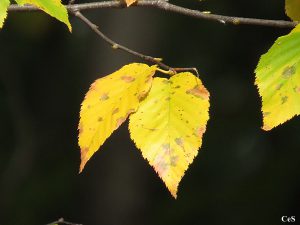There are signs of autumn everywhere. For many the true indication is the turning of trees’ leaves from green to various shades of red, yellow, orange and brown.
 Look at the hillsides and you may see the first yellow leaves appearing on the birch trees; black, yellow and white birch are among the first trees to change color – frequently beginning to change in mid to late August and reaching their peak in early to mid-September.
Look at the hillsides and you may see the first yellow leaves appearing on the birch trees; black, yellow and white birch are among the first trees to change color – frequently beginning to change in mid to late August and reaching their peak in early to mid-September.
And what causes the trees to change color? Some people believe it’s a frost – but it’s not. What causes tree leaves to change color is actually the shortening days. And the colors are the result of pigments in the leaves:
• Chlorophyll, the pigment that gives leaves their green color. It is where photosynthesis occurs whereby plants use sunlight to manufacture sugars. Toward the end of the growing season chlorophyll is broken down and no more is produced.
• Carotenoids that produce the yellow, orange, and brown colors in other plants like corn, bananas, carrots, and daffodils. These pigments are also present in leaves throughout the summer.
• Anthocyanins, are reddish pigments which color cranberries, apples, cherries and strawberries. These pigments form in the leaves in late summer and fall as the leaves prepare to fall from the tree and sugars are trapped in the leaves.
When all the chlorophyll in the leaves is destroyed the carotenoids and anthocyanins are revealed and with that the fall coloration is created.
Warm, sunny days and cool, but not freezing, nights usually produces the most glorious red and orange colors. That’s because during the day a lot of sugars are produced in the leaf but the cool nights and closing of the vessels between the leaf and twig keep the sugars in the leaf. A lot of sugar and a lot of light produce bright anthocyanin pigments. Because the yellow and brown pigments are always present in leaves, the yellow and gold colors don’t vary much from year to year.

